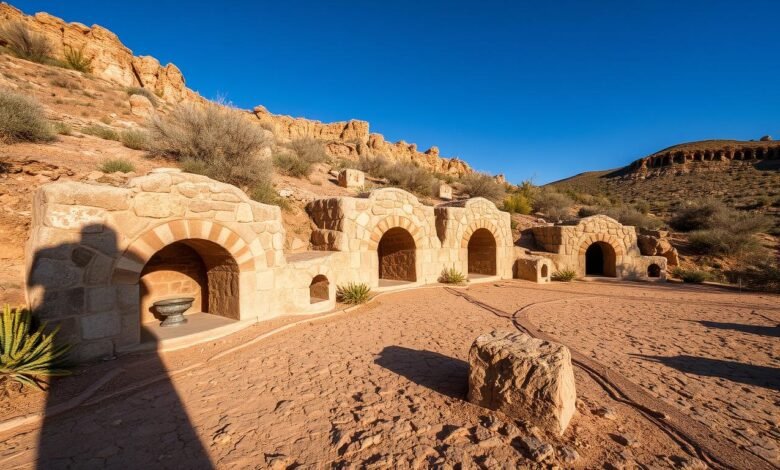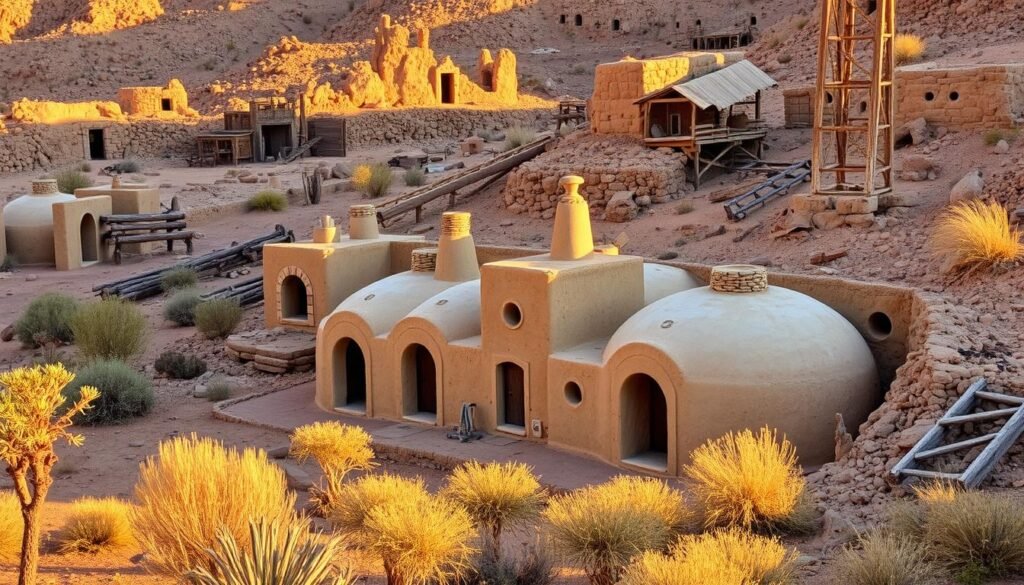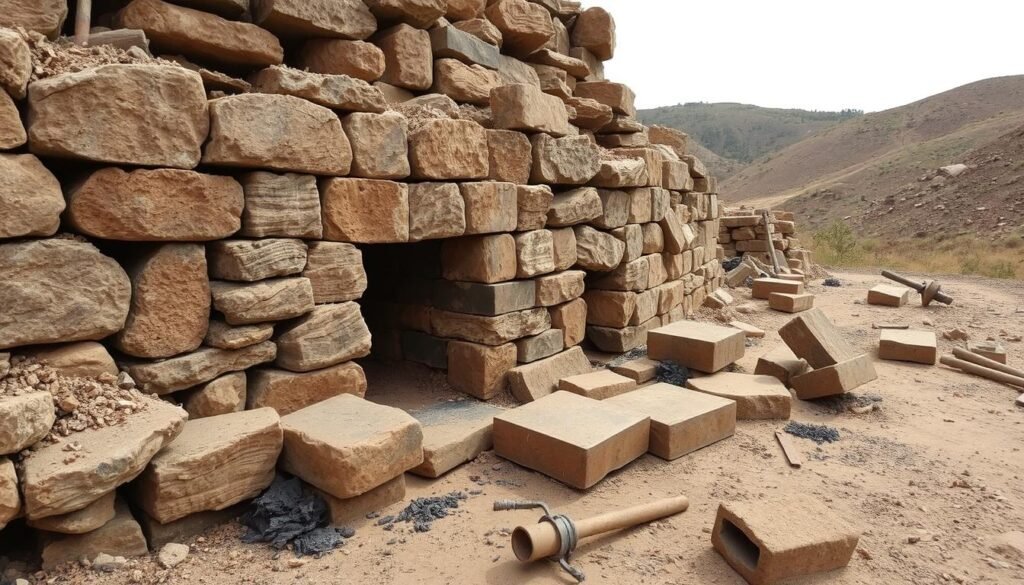Exploring Old Mexican Mining Ovens – A Guide

Old Mexican mining ovens, especially the adobe ones, are crucial to Mexico’s mining past. These historic ovens show the old engineering skills. They also highlight how important they were in mining, helping to melt metals which boosted the economy.
In this guide, we explore the deep history and design of these amazing adobe ovens. We’ll see how they played a big part in mining and shaped Mexico’s culture.
Key Takeaways
- Old Mexican mining ovens are vital to understanding colonial mining heritage.
- Adobe ovens reflect the engineering prowess of ancient Mexican civilizations.
- These ovens played an essential role in the smelting processes of mining.
- Exploration of adobe ovens reveals insights into historical mining practices.
- Old mining ovens contribute significantly to Mexico’s economic history.
Introduction to Old Mexican Mining Ovens
Old Mexican mining ovens, known as hornos de cal, were key during colonial times. They flourished from the 16th to the 19th centuries. Crafted with local adobe, they showcase the era’s technology and skill. Adobe’s insulation was crucial for their efficient use.
These ovens mainly produced quicklime, essential for metal smelting including silver and gold. They did more than just function. They boosted local economies and helped communities grow around the mines. Today, their cultural significance is still visible where colonial mining flourished.
Preservation of these ovens has become important. Efforts are underway to protect these historical treasures. For more details on their importance, visit this descriptive link.
| Feature | Description |
|---|---|
| Construction Material | Adobe |
| Operational Period | 16th to 19th centuries |
| Primary Use | Producing quicklime for smelting |
| Metals Processed | Silver, Gold |
| Cultural Impact | Community development and economic growth |
The Historical Significance of Mining Ovens
Mining ovens in Mexico during the colonial era were very important. They were key for melting precious metals in famous mining towns like Zacatecas and Guanajuato. When the Spanish arrived, they found a lot of silver and gold. This discovery led to a mining boom that helped the area’s economy and its role in world trade.
These ovens were essential in getting resources from the ground, affecting markets around the world. As time went on, their design and use got better, showing off new technology. We can still see the mining heritage in old buildings. They mix local methods with European tech.
Back then, Zacatecas and Guanajuato made lots of silver. The silver they mined was worth more than 200 million pesos and was key to Spain’s riches. But these ovens did more than make money. They also changed how people lived and the culture in mining towns.
| Mining Town | Annual Silver Production (Pezos) | Historical Timeline |
|---|---|---|
| Zacatecas | 150 million | 1546 – Present |
| Guanajuato | 70 million | 1548 – Present |
We can learn a lot by looking at the importance of mining ovens. They tell us about Mexico’s past and how colonial times changed resources and people’s lives.
Understanding Adobe Ovens in Mining History
Adobe ovens were crucial in mining history because they were practical and efficient. They are made from sustainable materials. This shows the value of traditional building methods that last long. They could handle the tough conditions of mining areas well.
Adobe is made of clay, sand, and straw. Miners built structures with it that stood up to high heat. This helped a lot in melting metals. The materials came from nearby places, which was good for the planet. It shows how building can be done in a way that doesn’t harm the environment.

Adobe ovens are known for their durability. They weren’t just useful; they also showed the culture of the miners’ communities. Looking at old building methods shows us how to use local materials well. It gives ideas for making buildings today in a way that’s better for the earth. Using these green methods in new buildings keeps the tradition of adobe ovens going.
Architectural Features of Mexican Adobe Ovens
Mexican adobe ovens combine practicality with unique design, especially seen in old mines. The dome-shaped roof stands out. It keeps heat in and allows air to move freely, which is key for melting metal effectively.
The ovens’ walls are made thick from adobe for great insulation. They keep the inside temperature steady, no matter the weather outside. The doors of these ovens are also special. They are made to let air in and help the fire burn better.
The beauty of these ovens shows the builder’s artistic side and their smart building methods. Using materials found nearby, miners made ovens that lasted and worked well in their tough daily mining work.
| Architectural Feature | Description | Significance |
|---|---|---|
| Dome-shaped roof | Curved roof structure for heat retention | Enhances air circulation and heat efficiency |
| Thick walls | Made from adobe to provide insulation | Maintains consistent internal temperatures |
| Entrance design | Designed to facilitate airflow | Improves fuel combustion and heat distribution |
Looking at traditional Mexican adobe ovens, we see how smart design leads to effective structures. We learn to value the craftsmanship and skill of those in the past. They combined practicality with beauty in their work.
Old Mexican Mining Ovens and Colonial Mining Practices
In the past, Old Mexican mining ovens were key to the mining industry. These ovens helped miners extract valuable metals from ores effectively. The methods used in these ovens changed a lot, meeting market demands.
Miners worked hard to get precious metals out of tough rock. Old mining ovens helped make smelting more efficient. The blend of old wisdom and local practices improved mining methods and metal output.
These techniques had a big impact on the economy back then. Mining operations supported local towns and increased the need for skilled workers. This shows how old mining ovens and colonial mining practices were closely linked.
| Aspect | Details |
|---|---|
| Key Function | Smelting metals from ores |
| Challenges Faced | Extracting precious metals from hard rock |
| Evolved Techniques | Enhanced mining practices, improved yields |
| Economic Impact | Increased support for local communities and skilled labor demand |
Exploring Historic Mining Sites in Mexico
Mexico has many amazing historic mining sites. States like Zacatecas, Durango, and Guanajuato are home to them. These places show old mining ovens that were key in mining work.
These sites are great for tourism. They draw in history lovers and teach about mining’s role in local economies and cultures. They are kept as cultural heritage, letting future generations learn their value.
Guided tours bring the mining history to life for tourists. Local museums also have exhibits on these ovens and mining traditions.
Educational programs at these sites help visitors understand mining’s community and environmental impacts. This adds depth to the tourism experience.
| State | Notable Sites | Tourism Opportunities | Cultural Heritage Aspects |
|---|---|---|---|
| Zacatecas | Mineral de Zacatecas | Guided tours, workshops | Historic silver mining techniques |
| Durango | Gomez Palacio | Museum exhibits, local festivals | Spanish colonial mining influence |
| Guanajuato | La Valenciana Mine | Historical reenactments | Cultural traditions and celebrations |
Types of Old Mexican Mining Ovens
The old Mexican mining ovens show a variety of types of ovens important for mineral extraction. Different ovens had unique roles, based on what miners needed. For example, some were for smelting silver, others processed various minerals.
In different areas, these ovens had regional variations. This happened because of the resources and cultural influences nearby. Miners would change their oven designs depending on what they had and what conditions they faced. Here’s a look at the types of old Mexican mining ovens:
| Type of Oven | Primary Functionality | Regional Variations |
|---|---|---|
| Adobe Smelting Ovens | Used for smelting silver and other metals. | Common in Zacatecas, influenced by indigenous building techniques. |
| Stone Kilns | Ideal for burning limestone and related processes. | Predominantly found in regions with abundant limestone deposits. |
| Clay Ovens | Primarily for roasting minerals before extraction. | Regional variations reflect local clay types and available resources. |
| Open-Fired Fornos | Used for more basic processing and heating needs. | Less common, with certain designs found near coal mines. |
The way these types of ovens were used shows the miners’ cleverness. They made the best out of what they had around them. Knowing about these ovens helps us understand Mexico’s deep mining history.
How Mine Smelters and Kilns Functioned
Mine smelters and kilns played a big role in making metal from raw ores. They used heat in special ways to get usable metals. The process needed heat and materials called fluxes to take away impurities and get more metal.
The science behind smelting is really interesting. Ores change when heated, separating metal from waste. This process makes gases and other leftovers. The right temperature and kiln quality are key. Newer kilns are better at keeping heat in and using less fuel while giving more metal.
New technologies have really changed mining. They make it easier to control temperature and keep heating steady for better smelting. Below is a table showing how old and new kilns compare:
| Feature | Traditional Kilns | Modern Kilns |
|---|---|---|
| Heating Efficiency | Lower | Higher |
| Temperature Control | Manual | Automated |
| Fuel Consumption | Higher | Lower |
| Emissions | Higher | Lower |
| Output Consistency | Variable | Stable |
Thanks to tech advances and smarter chemistry, mine smelters and kilns are getting better. They’re making mining more efficient and less harmful to the planet.
Materials Used in Construction of Mine Furnaces
Mine furnaces were mostly built using local resources. This ensured easy access and was better for the environment. Adobe was a popular choice because it kept a good temperature and was easy to get. It is made from clay and water, dried by the sun, and keeps heat well.
Stones and bricks were also important. They were taken from close by. These materials were chosen for being strong, keeping heat well, and fitting the furnace’s needs. Getting materials locally cut down on costs and made transporting them easier. In mining towns, using local resources was eco-friendly and made everything look natural.
When getting materials, the community worked together. Builders, miners, and crafters shared tips on using natural resources well. Their teamwork made sure mine furnaces lasted long and worked well even in tough situations.

| Material | Source | Benefits |
|---|---|---|
| Adobe | Local soil | High thermal efficiency, low cost |
| Stone | Nearby quarries | Durability, structural integrity |
| Brick | Local artisans | Consistent quality, fire resistance |
The Role of Adobe Brick Ovens in Mining Communities
Adobe brick ovens were crucial in mining communities. They went beyond cooking meals. They were where people came together. The warmth they provided was like the warmth found in strong community ties. This setting was perfect for telling stories and passing down traditions.
These ovens helped form a unique community identity in mining areas. Families celebrated together around them during festivals and special days. They brought joy to both rural and urban settings. People enjoyed many loved dishes, creating a deeper social bond and cultural ties.
Even today, adobe brick ovens are still influential. Efforts to preserve these ovens also boost community engagement and help teach about the culture. The legacy of these ovens shows the lasting vigor of mining communities. They demonstrate how the past still informs our present.
| Aspect | Details |
|---|---|
| Functionality | Used for cooking meals, baking traditional foods |
| Cultural Significance | Center of gatherings, storytelling, and cultural events |
| Community Identity | Symbol of heritage, reflecting local traditions and practices |
| Legacy | Continues to influence contemporary community activities and preservation efforts |
Conclusion
Old Mexican mining ovens are a mark of past wisdom and toughness. They’re not just old things. They connect yesterday with today. Their design and how they were used tell us a lot about old mining days. The way they were made, using adobe, shows their creativity and smart solutions to problems.
These ovens tell a wider story about Mexico’s mining history. They give us clues about the social and economic issues of the time. Looking ahead, it’s clear we need to study and protect them. This way, we keep alive the knowledge and achievements of those who came before us.
Old Mexican mining ovens deserve everyone’s interest, not just experts’. Understanding their importance helps us feel closer to a complex history. It also encourages more studies and interest in their lasting value. Such work helps teach us and future generations about an important part of Mexico’s story.



